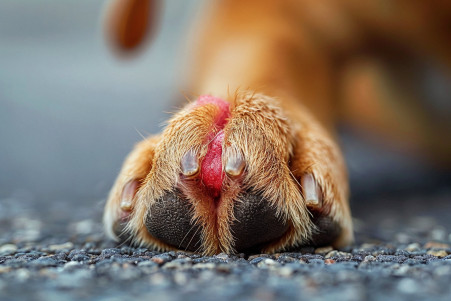Dog Heat Rash: Causes, Treatments, and Prevention
30 March 2024 • Updated 29 March 2024

As the weather gets warmer, dog owners may start to see their pets dealing with heat rashes. But what causes these red, irritated patches of skin, and how can they be avoided or treated? Heat rashes, also known as "prickly heat" or "sweat rash," happen when a dog's sweat glands get clogged or inflamed, often because of hot and humid weather or exercise. This leads to sweat and bacteria getting trapped under the skin, which results in red, itchy bumps that can even get infected if they're not treated.
To learn more about what causes heat rashes in dogs and how to best treat and soothe this common issue, we'll take a look at the most recent veterinary studies and talk to dog care professionals. We'll explore a number of studies to find out more about what causes heat rashes, which dogs are most at risk, the best treatments and at-home care, and how dog owners can help their pets avoid heat rashes and stay comfortable in the summer.
What causes dog heat rash?
How to Recognize Heat Rash in Dogs: Signs and Symptoms
If you’re a dog parent, you know that few things are more distressing than seeing your dog in pain. Heat rash, a common condition that occurs in warm weather, can show up in a number of ways, from red bumps and blisters to itching and scratching. According to The Spruce Pets, the most common signs of heat rash are found in areas where the skin is thin and hair is short, such as the belly, armpits, groin, and skin folds.
Petcube lists the most common symptoms as redness, sensitivity, bumps or pimples, sores, scabs, a bad smell, and in severe cases, bleeding. As East Valley Animal Hospital points out, dogs will often scratch and lick the area where they have heat rash. While these symptoms can be distressing, it’s important to get your dog to the vet as soon as possible if you notice them, especially if the symptoms don’t go away or get worse.
Heat rash is diagnosed through a physical exam and by ruling out other skin conditions. According to Daily Paws, your vet may take skin samples to check for infections, which can occur if heat rash is left untreated. It’s also important to differentiate between heat rash and other skin conditions, such as hot spots, allergies, and bacterial infections, as each of these conditions will require different treatments.
While heat rash may go away on its own, keeping an eye on it and getting your dog to the vet when necessary can help prevent your dog from experiencing discomfort and other issues. By learning the signs and symptoms of heat rash and acting quickly when you notice them, you can help ensure that your dog stays comfortable and itch-free this summer.
How to Get Rid of Dog Heat Rash: Home Remedies and Medical Treatment
To help your dog find relief from heat rash, there are a number of home remedies that can be used to treat mild cases. The Spruce Pets suggests that hydrocortisone creams can help to reduce redness and inflammation, while aloe vera gel can help to soothe the skin. AKC Pet Insurance also suggests using cool compresses to help reduce the heat and inflammation that comes with heat rash.
It’s important to keep the area clean and to make sure that the dog doesn’t scratch or lick the rash. Holistic Pet says that cleaning the rash with a mild antiseptic solution can help to kill bacteria. However, if the rash is severe, if it’s not going away, if it’s getting worse, if there are signs of infection, or if home remedies aren’t working, it’s important to seek medical care.
If you do seek medical care, a veterinarian may prescribe medicated shampoos, oral medications, or antibiotics to help treat secondary infections, according to Yahoo Sports. It’s important to follow the vet’s instructions and to keep an eye on the rash for any changes or complications to ensure that it’s managed properly and that there are no long-term problems.
While home remedies can help to manage heat rash, it’s important to seek medical care, especially if the rash isn’t improving or if it’s getting worse. With the right care, dog owners can help their pets stay comfortable, cool, and free from itching during the summer months.
Breed Predisposition: Breeds More Likely to Get Heat Rash
Some dog breeds are more likely to get heat rash because of their specific physical traits. For example, as mentioned by PetMD, brachycephalic breeds like Bulldogs, Boxers, and Pugs are more susceptible to heat-related problems, including skin irritations and rashes, because they can't cool themselves down as effectively through panting due to the difference in sweat gland distribution between dogs and humans.
Moreover, dogs with long, thick coats and skin folds, such as Shar-Peis and English Bulldogs, are more likely to develop heat rash according to PetMD. The skin folds and wrinkles can trap heat and moisture, which can lead to bacterial and yeast infections that cause red, itchy rashes.
In addition, as Montgomery Veterinary Associates points out, dogs with a history of skin issues like dermatitis and hot spots are more likely to get heat rash. This means that people who own these breeds should be especially careful to make sure that their dogs stay cool, dry, and safe from the sun during hot weather to avoid any discomfort or complications.
How to Avoid Heat Rash in Dogs
Since heat rash can lead to more serious problems, it's important to know how to avoid it. According to Montgomery Veterinary Associates, the best way to prevent heat rash is to keep dogs cool and inside during the hottest parts of the day. It's also important to make sure dogs have access to shaded areas and plenty of water.
In addition to these measures, grooming and coat maintenance can help reduce the risk of heat rash. Tomlinson's Feed suggests avoiding extended periods outside when the sun is at its peak and scheduling exercise for the cooler morning and evening times. For dogs that are especially prone to overheating, cooling gear like vests or bandanas can be helpful.
According to PawSafe, staying hydrated and well-ventilated and avoiding irritants are the best ways to prevent heat rash and the issues that can come with it, including skin cancer, infection, and chronic skin problems. However, with a little planning and care, dog owners can keep their pets safe and comfortable and prevent heat rash this summer.
Long-Term Implications: Dealing With Chronic or Severe Heat Rash
If it goes untreated or becomes severe, heat rash in dogs can have a number of long-term implications. For example, as Small Door Veterinary points out, if hot spots aren't treated, the skin can become necrotic and die, leading to open wounds that are susceptible to infection and slow to heal. Zoetis Petcare also notes that the constant scratching and licking that can occur with skin irritation can cause the skin to break, which can make it more susceptible to bacterial or fungal infections.
Chronic or worsening heat rash can also be a sign of an underlying health issue, such as an allergy or an immune system problem, according to Daily Paws. This is why it's important to get your dog to the vet right away if you notice that their heat rash isn't improving. In order to prevent the heat rash from coming back, the underlying issue will need to be diagnosed and treated.
Even after the rash has cleared up, PawSafe stresses the importance of continued monitoring and care. If it's left untreated, heat rash can lead to long-term skin issues, including increased sensitivity to the sun's UV rays and a higher risk of skin cancer. That said, most cases of heat rash in dogs can be managed with treatment and preventive care, which will help ensure that your dog stays happy and healthy.
Conclusion: How to Help Your Dog Stay Healthy and Happy
By learning about the causes, symptoms, and treatment options for dog heat rash, dog owners can help make sure their pets stay cool, comfortable, and healthy when the weather gets warmer.
It’s also important to make sure that you seek veterinary attention when your dog needs it, and to take steps to prevent heat rash from occurring in the first place. With the right care, dogs can enjoy the summer without having to deal with the pain and discomfort of heat rash.


